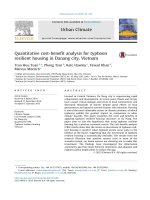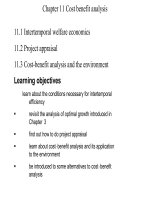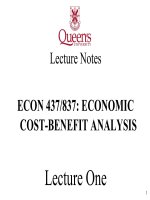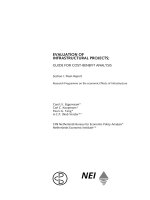Cost benefit analysis
Bạn đang xem bản rút gọn của tài liệu. Xem và tải ngay bản đầy đủ của tài liệu tại đây (661.31 KB, 48 trang )
Chapter 11 Cost benefit analysis
11.1 Intertemporal welfare economics
11.2 Project appraisal
11.3 Cost-benefit analysis and the environment
Learning objectives
learn about the conditions necessary for intertemporal
efficiency
revisit the analysis of optimal growth introduced in
Chapter 3
find out how to do project appraisal
learn about cost–benefit analysis and its application
to the environment
be introduced to some alternatives to cost–benefit
analysis
Cost-benefit analysis
Cost-benefit analysis, CBA, is the social appraisal of marginal
investment projects, and policies, which have consequences over time
It uses criteria derived from welfare economics, rather than commercial
criteria.
CBA seeks to correct project appraisal for market failure
Environmental impacts of projects/policies are frequently externalities,
both negative and positive
CBA seeks to attach monetary values to external effects so that they can
be taken account of along with the effects on ordinary inputs and outputs
to the project/policy
CBA is the same as BCA – Benefit-cost analysis.
Intertemporal efficiency
Given that CBA is concerned with consequences over time, and based in welfare
economics, a key idea is that of intertemporal efficiency.
U = U (C , C )
A
A
A
A
0
1
U = U (C , C )
B
B
B
B
0
1
(11.1)
An allocation is efficient if it is impossible to make one individual better off
without thereby making the other worse off.
Intertemporal efficiency requires the satisfaction of 3 conditions
Equality of individuals’ consumption discount rates
Equality of rates of return to investment across firms
Equality of the common consumption discount rate with the common
rate of return
Discount rate equality
A
C 0,c1
MRUS
r
=
A
C0, C1
otherwise one could be made better off without making the other
worse off
B
MRUS C 0,c1
≡
MRUS
A
C0, C1
−1
defines A’s consumption discount rate
Then the first intertemporal efficiency condition is stated as
rA=rB = r
(11.2)
Note: consumption discount rates are not constants.
Shifting consumption over time
Foregoing Cb0Ca0 makes Ca1Cb1 available next
period. The rate of return to, on,investment is
defined as
δ ≡
∆C1 − ∆I 0
∆I 0
where ΔC1 is the second period
increase in consumption, Ca1Cb1,
resulting from the first period
increase in investment ΔI0, Cb0Ca0.
For ΔI0 = ΔC0, this is
δ=
ΔC − (−ΔC ) ΔC + ΔC
ΔC
=
=−
−1
− ΔC
− ΔC
ΔC
1
0
0
1
0
0
1
0
which is the negative of the slope of the transformation frontier minus 1, which can
be written
1 + δ = −s
where s is the slope of the frontier.
Rate of return equality
If each firm were investing as indicated by C01b and C02b, then period 1
consumption could be increased, without loss of period 0 consumption, by
having firm 1, where the rate of return is higher, increase investment by the
amount firm 2, where the rate of return is lower, reduced its investment.
Only where rates of return are equal is this kind of period 1 gain
impossible. For N firms, the second intertemporal efficiency condition is
δ i = δ , i = 1,..., N
(11.3)
Equality of discount rate and rate of return
If the first two conditions are satisfied, can consider representative individual and firm.
Point a corresponds to intertemporal efficiency, b and c do not as from either could reallocate
consumption as between periods so as to move on to a higher consumption indifference curve.
At a the slopes of the consumption indifference curve and the consumption ttansformation
frontier are equal. The third condition is
δ =r
(11.4)
Intertemporal optimality
As in the single period situation, the intertemporal efficiency
conditions do not fix a unique intertemporal allocation.
That requires a social welfare function with utilities as arguments
Will consider this under ‘Optimal growth models’
Markets and intertemporal efficiency –futures markets
Futures Markets
X at t is treated as a different commodity from X and t+1
For N commodities and M periods there are MN dated commodities. Contracts are
written at the start of the first period for trades an all commodities at all future
dates.
Then, it is effectively the static case.
Given that all ideal circumstances apply in all MN markets, the conditions for
intertemporal efficiency will be satisfied.
Futures markets are, in fact, rare – standardised raw materials,
financial instruments.
Markets and intertemporal efficiency – loanable funds market
Loanable Funds Market
x−P
i=
P
b
b
x is the bond coupon paid on the first day of period 1
Pb is the price the bond trades for on the first day of period 0
i is the interest rate
A seller is a borrower
A buyer is a lender
Individuals - utility maximisation
UU is a consumption indifference curve, slope –(1+r)
Line C1max C0max is the budget constraint, slope –(1+i)
Optimum is at C*0 in period 0 and C*1 in period 1, where
r=i
which will hold for all individuals, satisfying the first
intertemporal efficency condition
Firms – present value maximisation
Owners of firms can shift consumption by
investing in firm
dealing in the bond market
AB shows C0 C1 combinations on account of
varying investment, slope –(1+ δ), δ is the
rate of return to investment
RS with slope -(1+i) shows how
consumption can be shifted via bond market
dealing.
The optimum level of investment is at a, where the present value of the firm is
maximised, and where
i=δ
In the second stage the owner maximises utility, by bond market dealing, at b where
i=r
All owners so act, and the three conditions for intertemporal efficiency are satisfied.
Optimal growth modelling; discrete time
A representative individual model for two periods
Maximise
1
W = U ( C0 ) +
÷U ( C1 )
1+ ρ
(11.5a)
subject to
Q0(K0) – (K1 – K0) = C0
(11.5b)
Q1(K1) – (K2 – K1) = C1
(11.5c)
Here the efficiency problem is trivial – consumption in one period can only be
increased by reducing it in the other period.
A necessary condition is
U C1
1+ ρ
=
UC 0
1+ δ
(11.6)
So with diminishing marginal utility, C1 is greater than C0 for
ρ, the utility discount rate, less then δ, the rate of return on
investment. For ρ = δ consumption is constant.
Optimal growth modelling: continuous time
Maximise
W = ∫ U(C )e dt
t =∞
t =0
− ρt
(11.7a)
t
Subject to
.
K = Q(K ) - C
t
(11.7b)
t
has necessary condition
.
UC
= ρ −δ
UC
(11.8)
where ρ is a parameter, the utility discount rate, and δ is a variable,
the rate of return to capital accumulation. For δ > ρ, given
diminishing marginal utility, C is growing. Consumption growth
ceases when δ = ρ.
Optimal growth in the basic model
A model with resource input to production
Maxximise
W = ∫ U(C )e dt
t =∞
t =0
(11.9a)
− ρt
t
Subject to
.
K = Q ( K t , Rt ) − Ct
.
S = − Rt
(11.9b)
(11.9c)
In this model intertemporal efficiency is not trivial.
There are two forms of investment, in capital and in the resource stock.
Efficiency requires that the rates of return on the two are equal.
See chapter 14 especially
Utility and consumption discount rates 1
Figure 11.8 Indifference curves in utility and consumption space
1
W = U ( C0 ) +
1+ ρ
÷U ( C1 )
UC0
1/ ( 1 + ρ )
U C1
intertemporal welfare function for panel a
slope of WCWC in panel b
1 + ρ ) UC 0
UC 0
(
r=
−1 =
−1
U C1
1/ ( 1 + ρ ) U C1
(11.10)
Utility and consumption discount rates 2
In continuous time
r = ρ +η g
(11.11)
where
r is the consumption discount rate
ρ is the utility discount rate
η is is the elasticity of marginal utility for
the instantaneous utility function
g is the growth rate
For g>0 r> ρ and r would be positive for ρ = 0
For g = 0 r = ρ
Private project appraisal – the Net Present Value test 1
The present value of expenditures E is
E1
E2
ET
+
+ ... +
2
T
1+ i ( 1+ i)
(1+ i)
PVE = E0 +
T
=∑
0
Et
( 1+ i)
(11.14)
t
The present value of receipts R is
PVR = R0 +
T
=∑
0
R1
R2
RT
+
+ ... +
2
T
1+ i ( 1+ i)
(1+ i)
(11.15)
Rt
( 1+ i)
t
The present value of the project is
T
NPV = PVR − PVE = ∑
0
T
RT
( 1+ i)
t
−∑
0
Et
(1+ i)
t
(11.16)
Which for N = R - E is
NPV = N 0 +
T
=∑
0
N1
N2
NT
+
+ ... +
2
T
1+ i ( 1+ i)
( 1+ i)
Nt
( 1+ i)
t
The project should go ahead iff NPV≥0
(11.17)
Private project appraisal – the Net Present Value test 2
Year
Expenditure
Receipts
Net cash flow
0
100
0
–100
1
10
50
40
2
10
50
40
3
10
45.005
35.005
4
0
0
0
Table 11.2 Example net cash flow 1
at i = 0.05, NPV = £4.6151
at i = 0.075, NPV = £0
at i = 0.10, NPV = -£4.27874
The NPV of a project is the amount by which it increases the
firm’s net worth. It is the present value of the surplus, after
financing the project, at the end of the project lifetime.
Private project appraisal - risk
Year
Net cash flow 1
Probability 0.6
Net cash flow 2
Probability 0.4
Year
Expected net cash
flow
Present value of
expected cash flow
0
–100
–100
0
–(0.6 x 100) + {–(0.4 x
100)} = –100
–100
1
40
35
1
(0.6 x 40) + (0.4 x 35) =
38
38/1.075 = 35.35
2
40
35
2
(0.6 x 40) + (0.4 x 35) =
38
38/1.0752 = 32.88
3
(0.6 x 35.005) + (0.4 x
25) = 31.003
31.003/1.0753 = 24.96
4
(0.6 x 0) + (0.4 x 0) = 0
3
4
35.005
0
25
0
Table 11.4 One project, two possible cash flows
Expected
NPV
–6.81
Table 11.5 Calculation of expected NPV
Where the firm is prepared to assign probabilities, the criterion for going ahead with the project is
the expected NPV – the probability weighted sum of the mutually exclusive cash flow outcomes.
This assumes that the decision maker is risk-neutral
Chapter 13 on decision making in the face of imperfect knowledge of the future .
Social project appraisal
CBA is the social appraisal of projects
CBA uses the NPV test
CBA can be approached in two ways
As an extension of private appraisal where externalities are taken into
account
In terms of social welfare enhancement
The first stages of CBA are
proper project/policy identification
forecasting all of the consequences of the project/policy for all of the
affected individuals in each year of the project/policy lifetime
Then
expressing consequences in terms of monetary gains/losses for
aggregation to an NPV number
Social appraisal: an illustrative project
Time period
Individual
0
1
2
3
Overall
A
NBA,0
NBA,1
NBA,2
NBA,3
NBA
B
NBB,0
NBB,1
NBB,2
NBB,3
NBBB
C
NBC,0
NBC,1
NBC,2
NBC,3
NBC
Society
NB0
NB1
NB2
NB3
Table 11.6 Net benefit (NB) impacts consequent upon an illustrative project
NPV = NB0 +
NB3
NB1 NB2
+
+
1 + r ( 1+r ) 2 ( 1+r ) 3
Generally, go ahead if
t =T
NPV = ∑
t =0
NB t
>0
(1 + r) t
(11.19)
CBA as a potential pareto improvement test
A positive NPV indicates that, with due allowance for the dating of costs and benefits, the project delivers a
surplus of benefit over cost. The consumption gains involved are greater than the consumption losses, taking
account of the timing of gains and losses. The existence of a surplus means that those who gain from the
project could compensate those who lose and still be better off.
Finance by taxation – two periods
The initial investment is ΔI0, equal to -ΔC0, and the consumption increment on account of going ahead with
the project is ΔC1. First period consumers lose an amount ΔC0, equal to ΔI0, and second period consumers
gain ΔC1, and the question is whether the gain exceeds the loss. From the viewpoint of the first period, the
second period gain is worth ΔC1/(1+r), so the question is whether
ΔC1/(1+r) > ΔI0
(11.20)
is true, which is the NPV test discounting at r.
Finance by borrowing – two periods
The government funds the project by borrowing and the project displaces the marginal private sector project
with rate of return δ. In this case the cost of the public sector project is ΔI0 in the first period plus δΔI0 in the
second, this being the extra consumption that the private sector project would have generated in the second
period. In this case, from the viewpoint of the first period, the gain exceeds the loss if:
ΔC
δΔI
> ΔI +
1+ r
1+ r
(11.21)
1
0
0
This is the NPV test with the consumption gain discounted at the consumption rate of interest, and compared
with the cost of the project scaled up to take account of the consumption that is lost on account of the
displaced private sector project.
CBA as welfare increase test 1
Time period
Individual
0
1
2
3
Overall
A
ΔUA,0
ΔUA,1
ΔUA,2
ΔUA,3
ΔUA
B
ΔUB,0
ΔUB,1
ΔUB,2
ΔUB,3
ΔUB
C
ΔUC,0
ΔUC,1
ΔUC,2
ΔUC,3
ΔUC
Society
ΔU0
ΔU1
ΔU2
ΔU3
Table 11.7 Changes in utility (∆U) consequent on an illustrative project
∆W = W(∆UA,0,..., ∆UC,3) positive – the project should go ahead
Or
with an intratemporal social welfare function mapping individual utilities into a social
aggregate ∆Ut
∆W = W(∆U0, ∆U1, ∆U2, ∆U3) positive – the project should go ahead
where a widely entertained particular form is
ΔW = ΔU +
0
ΔU
ΔU
ΔU
+
+
1 + ρ (1 + ρ)
(1 + ρ)
1
2
3
2
3
is exponential discounting









